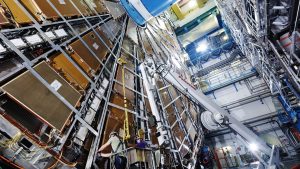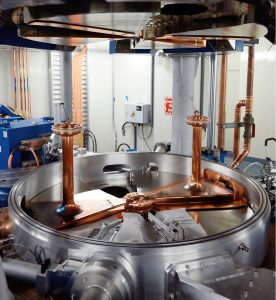Cooperation with Europe in Canada’s subatomic physics is evolving, and Triumf plays an important role in international research partnerships through its formal relationship with CERN and its contribution to high energy physics experiments.
In the late 1960s, a small team of physicists and engineers combined to sketch plans for the world’s largest cyclotron, making it clear that they were not building a particle accelerator on their own. Founded in 1968, Triumf, the Canadian Particle Accelerator Centre on the University of British Columbia campus, was conceived as a national laboratory with international aspirations.
These early aspirations now seem foresightful. More than 50 years later, Triumf is at the heart of the growing Transatlantic Research Alliance. This directly connects Canada not only to its own scientific future, but also to Europe’s most ambitious experiments and institutions. As science increasingly demands borderless thinking, Triumf and its European counterparts (particularly CERN, the European Institute for Nuclear Research) are weaving in the resources, expertise and ambitions to shape the next chapter in subatomic physics.
The recent signature of a statement of intent between Canada and CERN strengthens these decades of ties and marks a new era of formal cooperation. But behind the ink on that page is a year of stories driven by a common vision of advancement and development in areas such as high energy physics, radiopharmaceutical innovation.
Opening transatlantic channels for discovery
Triumf was born in an age of scientific nationalism. The Cold War had urged nations to stake sovereignty claims in a global research race. But even so, the establishment principle of Triumf, a collaboration with multiple Canadian universities to build and share major research facilities, suggests something greater.
Early collaboration with European institutions began modestly. In the 1970s and 1980s, Triumf scientists took part in overseas experiments at CERN, drawn by the size and scope of European infrastructure. CERN’s high energy corridors, including the Super Proton Synchrotron (SPS) and subsequently the large Hadron Collider (LHC), provided Canadian researchers with access to energy and detector technologies that are not available at home.
Conversely, Cyclotron technology, particularly Triumf’s expertise in producing intense beams of protons and rare isotopes, has begun to attract attention from European partners. Its isotope separator and accelerator (ISAC) facility became a world-renowned facility for rare isotope beam physics, complementing CERN’s Isoldo facility.
These early entanglements were primarily bottom-up. It is researcher-driven and evolves organically through common interests. But over time they became deeper, more strategic, and more visionary.
Corridor and Code:CERN Canada
Today, Canadian scientists are based at Triumf or its member universities, or many of them based at its member universities, are embedded deeply in CERN’s flagship high energy physics program. Canada is a full member of Atlas Collaboration and is one of the main experiments at the large-scale hadron crider (LHC), with the Canadian team playing a key role in accelerator infrastructure, detector development and data analysis.

As a Canadian particle accelerator centre, Triumf has become the anchoring agency for this involvement. Its engineers and physicists are contributing to Atlas Muon spectrometer and calorimeter systems, advanced data collection technology, and high-luminance LHC (HL-LHC) upgrades that require unprecedented accuracy and scale in increasingly harsh radiation environments. Collaboration with CERN is not limited to physical detectors. Increasingly, software and computing include invisible but important domains. The global LHC computing grid, which calculates the vast streams of data generated by LHCs, includes Canada’s Tier 1 and Tier-2 centres, with Triumf serving as a National Tier-1 hub. In other words, petabytes of data generated in Geneva pass through Vancouver to reveal new physics.
These scientific relationships reflect broader commitments, as Canadian researchers do not only participate in European projects. They are essential collaborators that shape them from within.
Building tools for tomorrow: Accelerator science as a bridge
Accelerator technology is a major pillar of modern experimental physics and is a field of research and development that is naturally suited to international collaboration. Both Canada and Europe have invested heavily in next-generation accelerator science, where Triumf is both a beneficiary and contributor. Europe’s future ambitions include projects such as The Future Circular Collider (FCC), a proposed 100km ring corridor that will warn the LHC, with Canadian researchers aiming for opportunities to contribute. But perhaps more immediately, Thorumuv is a unique programme on high frequency (SRF) acceleration, important for compact, high power beams, consistent with European developments at facilities such as German fairs (antiproton and ion research facilities) and Swedish European spitting (ESS).

In return, Canadian expertise in Cyclotron development has become an important resource for European partners. Triumf is home to the world’s largest cyclones, but it also operates a suite of smaller, compact cyclotrons used not only in research but also in the production of medical isotopes, a domain where synergy between Canada and Europe is beginning to accelerate.
Cross-border healing: Radiopharmaceuticals and medical isotopes
One of the lesser known but increasingly important threads in Canadian-European collaboration lies in the field of nuclear medicine.
Triumf has long been a world leader in the production of radiopharmaceuticals, materials that utilize short-lived radioisotopes within compounds that can visualize or even treat a variety of diseases such as cancer and Alzheimer’s disease. Triumf’s Life Sciences Division is pioneering innovative technologies to build and operate Canada’s first functional Positron Emission Tomography (PET) scanner and produce cyclotron-based research and clinical trials (including Technetium-99m and Technetium-99m including nuclear imaging work shoes).
These capabilities are currently finding resonance in Europe. Faced with the challenges of isotope supply, European hospitals and research institutes are turning to Canada for not only supply partnerships but also for technical collaboration. A joint research project between Triumf and European partners is investigating new routes of isotope production using cyclotrons rather than nuclear reactors. This is a more secure, more scalable, and more suitable approach to distributed healthcare systems. This isn’t just logistics. It is pushing the boundaries of radiopharmaceutical science. With the new GMP-compliant labs coming online online and close relationships between Advanced Medical Isotope Research Institute (IAMI) and Canadian biotech startups, Triumf serves as a key bridge between basic science, clinical applications, and scalable solutions for modern healthcare systems.
Statement of Intent: Formalization of the Future
All this momentum, including decades of shared experimentation, collaborative development tools and mutual expertise, reached its peak at a critical diplomatic moment. In April 2025, Canada and CERN intended to expand “planning for future projects” to enhance their collaboration in planning future projects, including future corriders (FCC), including future corriders. Fields – Accelerators, detectors, computing. ”
This document is not a full membership agreement for Canada to participate in CERN, but it is an iconic and practical milestone. We acknowledge the important role of Thorium in our involvement with CERN in Canada, and commit the parties to deeper cooperation in key areas, including participation in HLHC and other future conflicters, developing next-generation accelerator technologies, developing joint training and mobility for young scientists and engineers, and planning for large-scale infrastructure stores in the future.

For Triumf, the statement provides formal recognition of the role Canada has already played for decades as a window into European scientific ambitions. In the case of CERN, it means solidifying access to Canada’s brain power, hardware and computing power.
Importantly, the contract also brings political and cultural emphasis. When international collaboration faces geopolitical headwinds, Canada and Europe are doubling the idea that science works best when it crosses borders. As global scientific challenges become more complex and expensive, this kind of complementarity is invaluable. You can’t go it alone in particle physics. Thorium accelerators and isotope innovations, CERN’s corridor infrastructure, and its shared knowledge base – Canada and Europe are building a more powerful scientific ecosystem than its portions combined.
I look forward to: Shared Horizon
The Triumf and Cern story are, in a sense, a microcosm of modern scientific enterprises. What began as a series of informal collaborations among curious researchers has matured into intentional partnerships supported at the highest level.
The partnership is poised to grow in the future. Europe is thinking about the next megaproject, with Canadian scientists placing themselves in their contributions from day one. Canada is pondering its potential as a formal associate member, and is examining its deeper institutional involvement with CERN. At the same time, Triumf is expanding its infrastructure with its new facility, which positions the lab as the world’s leading producer of high-intensity isotope beams and with its Advanced Rare Isotope Research Institute (Ariel), a superconducting electron linear accelerator. In this unfolding story, Triumf is more than just a national research institute. It’s a scientific handshake for the Canadian world. And more and more, those handshakes are being repelled firmly from the entire Atlantic Ocean.
This article will also be featured in the 23rd edition of Quarterly Publication.
Source link

